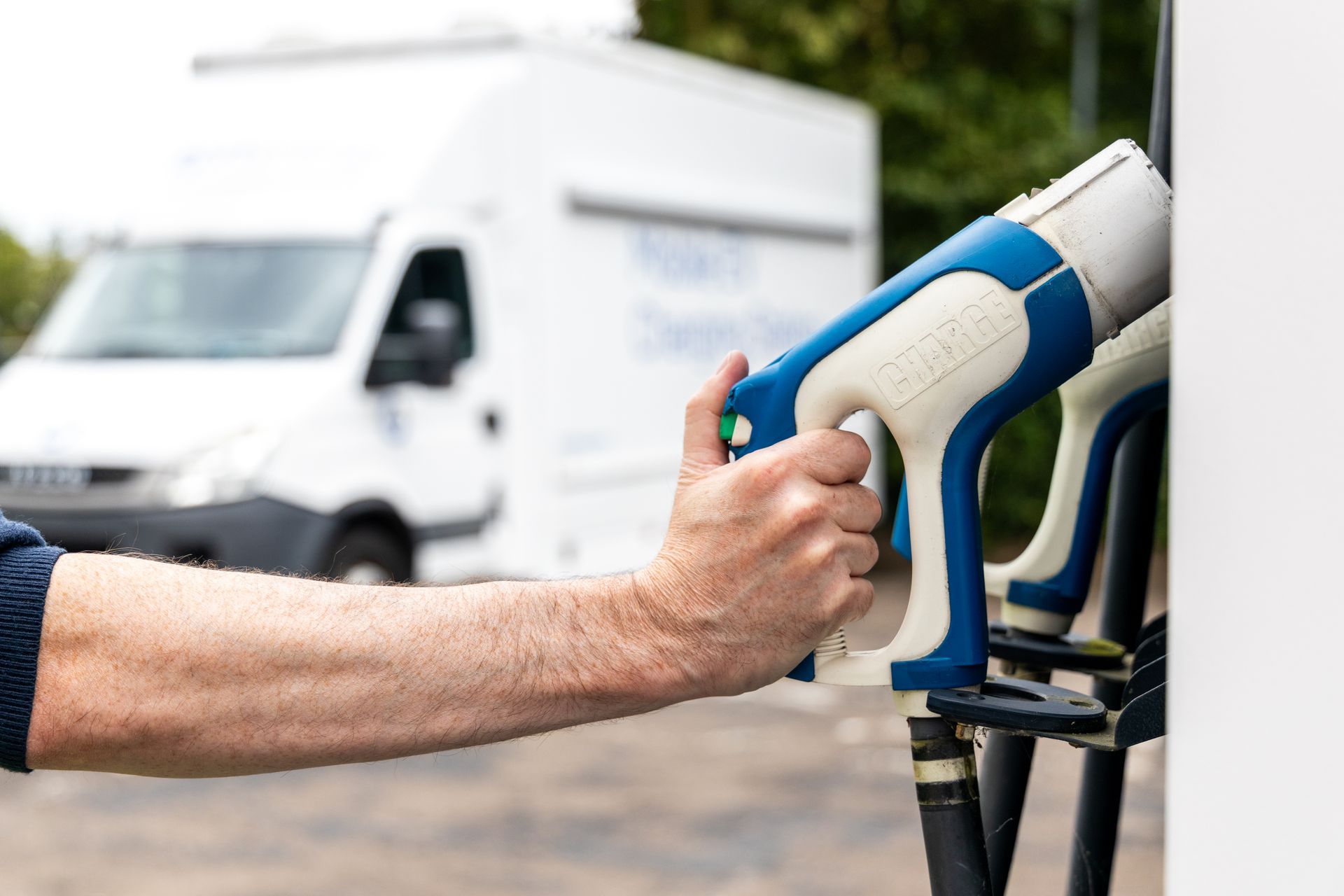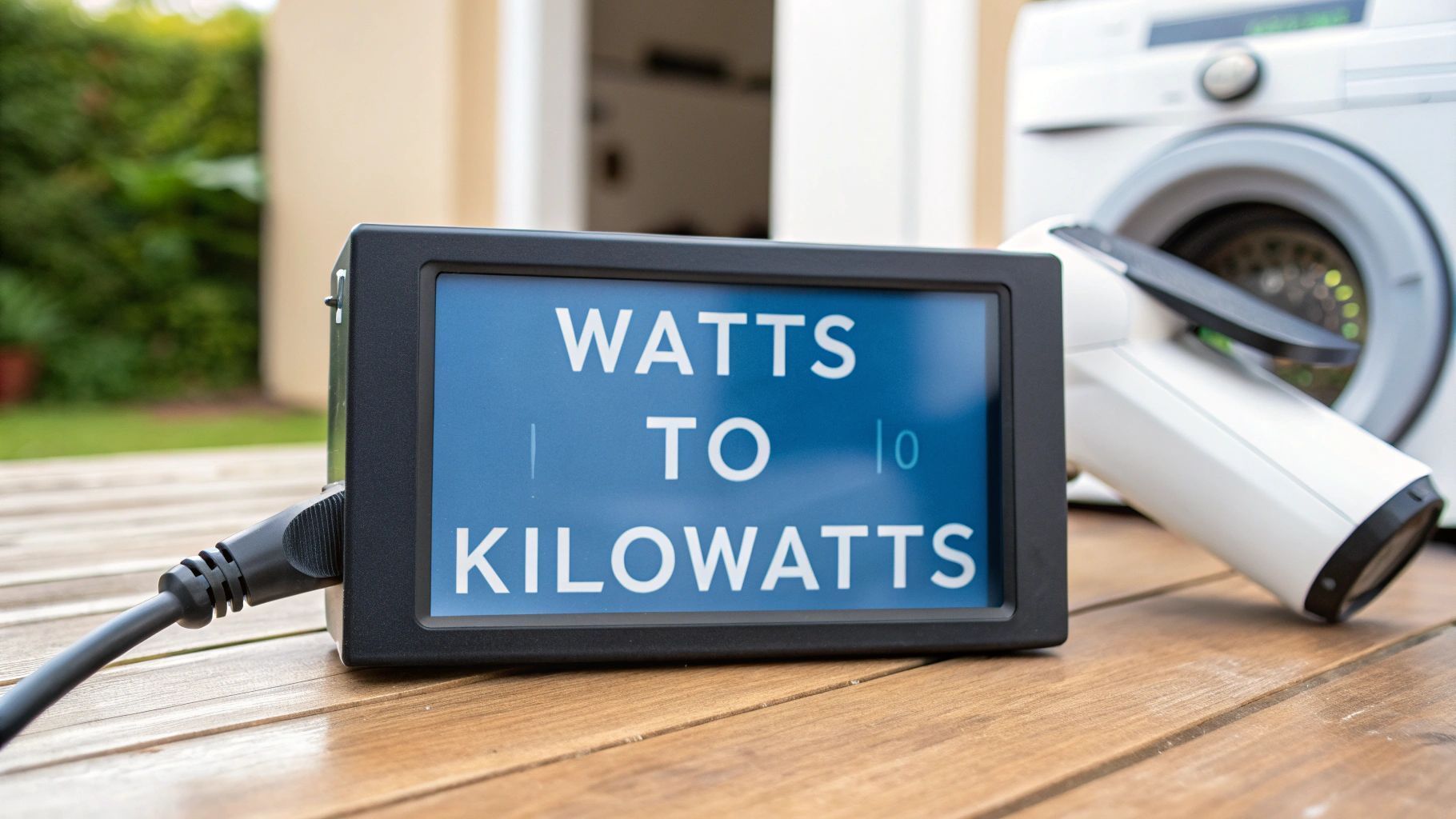UK Electric Car Charging Points Explained
Getting your head around electric car charging can feel like learning a new language at first but it's much simpler than it seems. The best way to think about the UK's charging network is like a new, improved system of petrol stations—only with far more options, often right where you live, work and shop. Let’s break down the essentials so you can power up with confidence.
Navigating the World of EV Charging
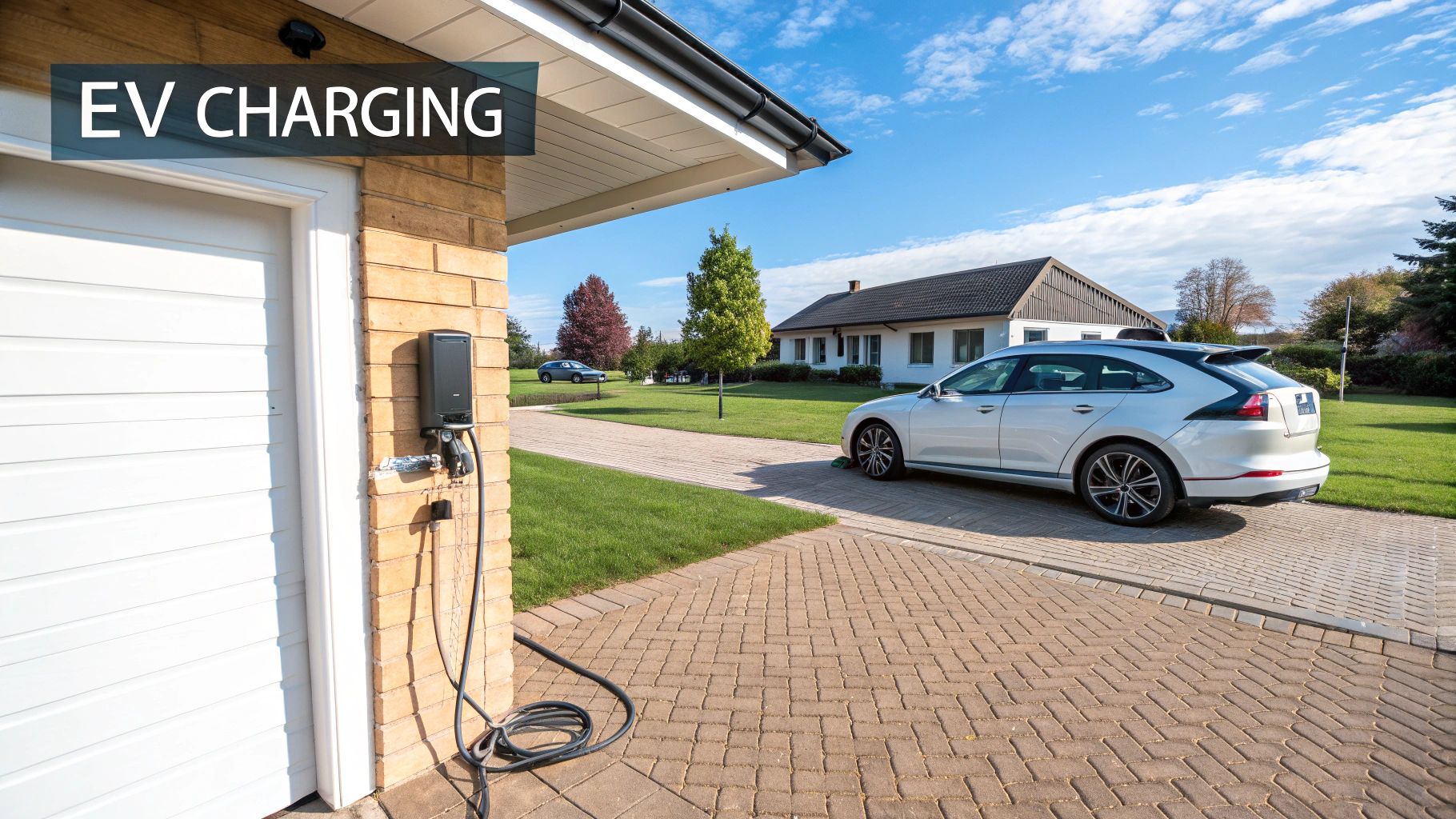
Switching to an electric car means changing how you think about "refuelling". Instead of making a dedicated trip to the petrol station, you'll mainly use electric car charging points . These are simply spots where you can plug your EV into the electricity grid to top up its battery.
It sounds technical but the reality is wonderfully simple. You charge your smartphone overnight, right? Well, you can do the exact same thing with your car using a home charger. You can also grab some extra range while you're doing the weekly shop or stopping for a coffee at a motorway service station.
The Growing UK Charging Network
Thankfully, the UK's charging infrastructure is growing at a phenomenal pace which means "range anxiety" is quickly becoming a thing of the past for most drivers. Finding a charger is getting easier by the day, with new points popping up everywhere. This boom is fuelled by both government incentives and private companies all working to make owning an EV a practical choice for everyone.
This expanding network gives you a mix of options to fit your lifestyle:
- Home Charging: This is your bread and butter. It's the cheapest and most convenient way to handle your daily charging needs.
- Workplace Charging: A great perk that more and more employers are offering their staff.
- Public Charging: These are the chargers you'll find at supermarkets, retail parks and dedicated charging hubs.
- Mobile Charging: A newer, flexible solution for emergencies or managing commercial vehicle fleets.
Understanding Mobile Charging's Potential
One of the most exciting developments in the EV world is mobile charging. Just picture a massive power bank on wheels that can come directly to you. This isn't just a clever idea for roadside rescues; it's also a serious business opportunity.
Mobile charging operators can generate substantial income by providing on-demand power where fixed infrastructure is lacking. This flexibility addresses a critical gap in the market, offering a lifeline to stranded drivers and a practical solution for businesses managing electric fleets.
Someone running a mobile charging service has a few ways to earn. They can charge a premium call-out fee for emergency boosts and then bill for the actual energy delivered, measured per kilowatt-hour. On top of that, they can secure lucrative contracts with businesses that need on-site charging for their fleets, creating a steady stream of income. It's an innovative model that turns a common EV headache into a profitable, green business. This guide will walk you through it all.
Understanding Charging Speeds and Connectors
Not all electric car charging points are built the same and knowing the difference is the secret to a stress-free EV life. The time it takes to recharge your battery comes down to one thing: the type of charger you’re plugged into. It’s a bit like filling a water bottle – you could use a slow kitchen tap or you could use a high-pressure fire hose.
The real difference lies in the kind of electricity being used. Your home’s electrical supply is Alternating Current (AC) but your car's battery needs Direct Current (DC) to store energy. This fundamental difference is why we have various charging speeds across the UK.
The Four Main Charging Speeds
When you pull up to a public charger, you'll generally find one of four speeds. Each one is designed for a specific scenario, from a slow overnight top-up at home to a lightning-fast pit stop on the motorway.
-
Slow (AC): These are the chargers you’ll likely have at home or work, typically offering 3kW to 7kW of power. They gently fill your battery over several hours – think 8 to 12 hours for a full charge – which is perfect for when the car is parked overnight.
-
Fast (AC): A step up from slow chargers, these deliver between 7kW and 22kW . You’ll often spot them in places like supermarket car parks, gyms and shopping centres where you might be parked for a couple of hours. A full charge can take between three and eight hours , giving you a really useful top-up while you're busy elsewhere.
-
Rapid (DC): Now we’re talking serious speed. Rapid chargers bypass the car's onboard converter and feed DC power directly into the battery. Starting at 50kW and going well over 100kW , they can get most EVs to 80% charge in just 20 to 60 minutes . They are the backbone of the UK’s long-distance charging network.
-
Ultra-Rapid (DC): As the name suggests, these are the fastest chargers you can find. Pushing out 150kW or more, an ultra-rapid unit can add hundreds of miles of range in the time it takes to grab a coffee, often in as little as 15 to 30 minutes .
This infographic gives you a great visual summary of how these speeds compare in the real world.
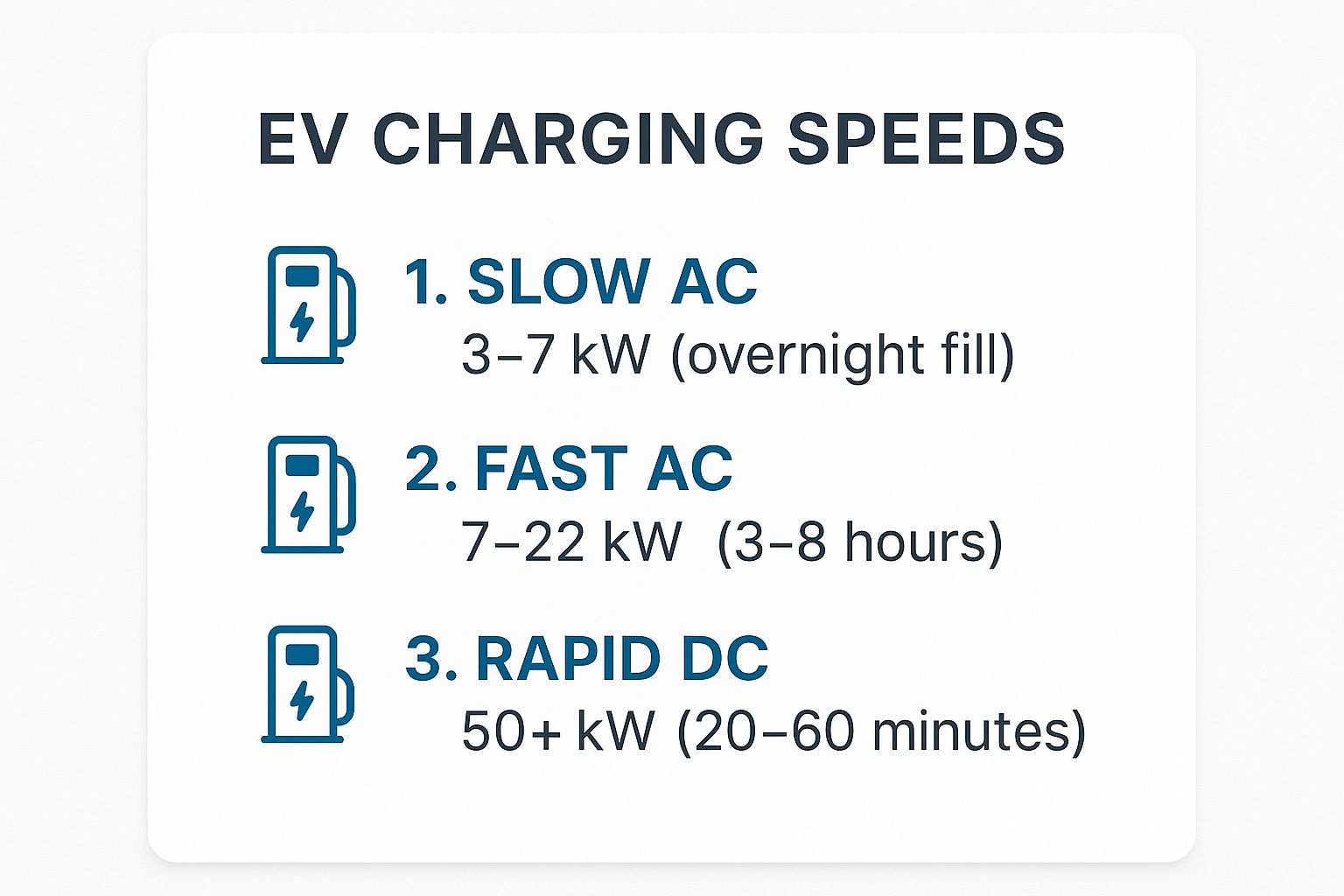
As you can see, the slower AC charging is brilliant for when your car is going to be parked for a while anyway, whereas DC charging is all about getting you back on the road as quickly as possible.
To help make sense of it all, here's a quick reference table.
UK EV Charging Speeds and Connectors at a Glance
| Charger Type | Power Output (kW) | Typical Charging Time | Common Connector(s) | Best Used For |
|---|---|---|---|---|
| Slow | 3kW - 7kW | 8-12 hours | Type 2 | Overnight home or workplace charging. |
| Fast | 7kW - 22kW | 3-8 hours | Type 2 | Topping up at destinations like shops or gyms. |
| Rapid | 50kW - 100kW+ | 20-60 mins (to 80%) | CCS, CHAdeMO | Quick top-ups on long journeys and motorways. |
| Ultra-Rapid | 150kW+ | 15-30 mins (to 80%) | CCS | The fastest option for getting back on the road. |
This table should give you a solid at-a-glance understanding of what to expect when you pull up to charge.
Matching the Plug to the Socket
Just as crucial as the speed is the connector. Your car has a specific charging port and you need a charger with a compatible plug. Thankfully, things have become much simpler in the UK over the last few years.
Think of it like phone chargers. Not long ago, every brand had its own unique plug. Now, almost everything has standardised on USB-C. The EV world has gone through a similar, very welcome, evolution.
Here are the main connector types you’ll come across:
-
Type 2: This is the universal standard for AC charging across the UK and Europe. If you have an EV sold in the last few years, it will almost certainly have a Type 2 socket for your slow and fast charging needs.
-
CCS (Combined Charging System): This has become the go-to standard for rapid DC charging. It’s basically a Type 2 socket with two extra DC pins added below it which cleverly allows for both AC and DC charging through one single port.
-
CHAdeMO: This was the rapid charging standard used by many early Japanese cars, like the original Nissan Leaf. You’ll still find CHAdeMO plugs on the public network but it’s being phased out in favour of CCS on new cars sold in the UK.
Knowing your car’s connector type is key but the good news is that most modern cars make it easy by using the CCS standard. For a really deep dive into the different plug types, have a look at our guide which explains every EV charger connector available today. Having this practical knowledge means you can plan your journeys with confidence and never waste time pulling up to the wrong charger again.
Mapping the UK Public Charging Network
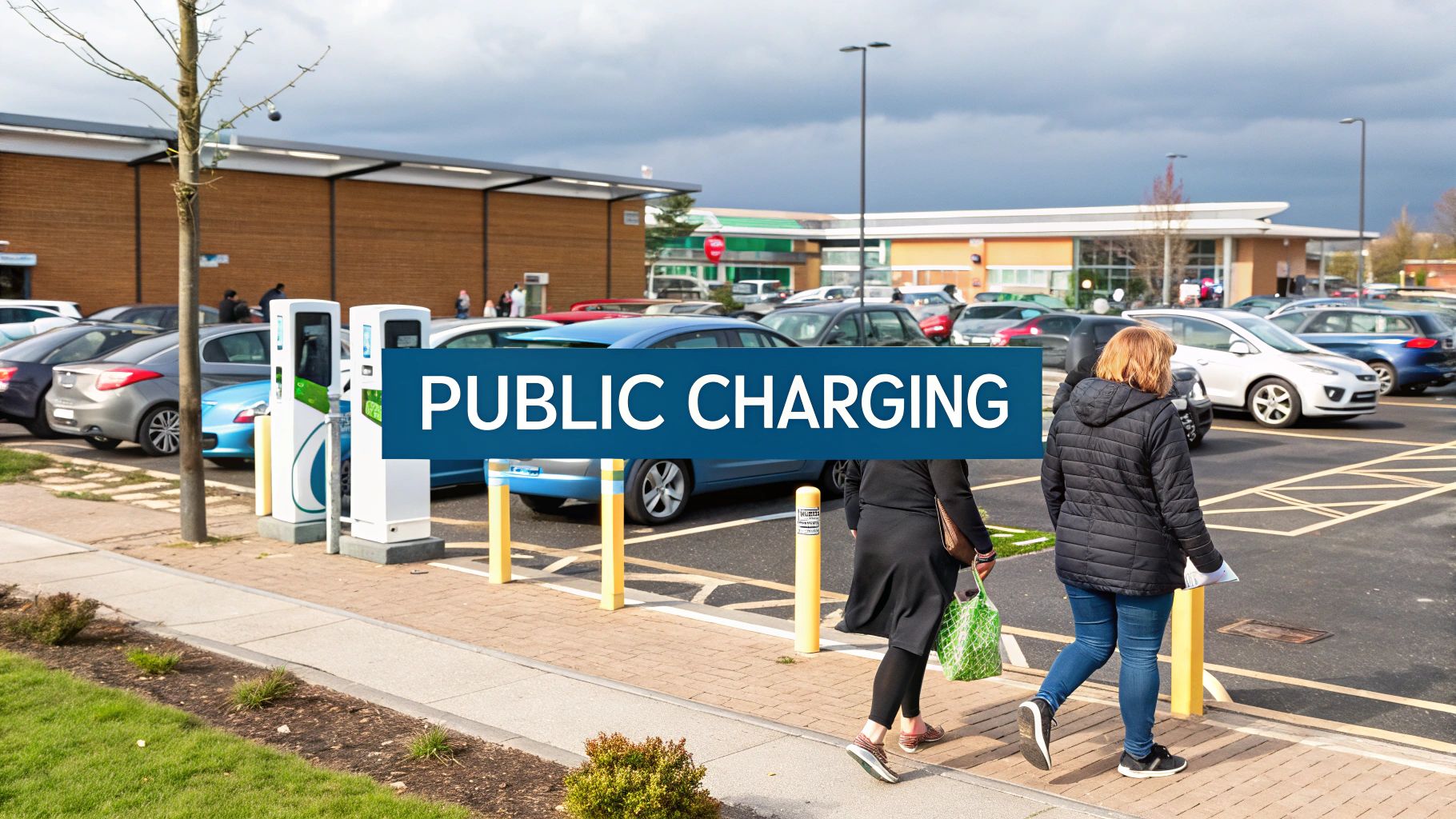
The UK’s network of public electric car charging points is growing at a phenomenal rate, completely changing the game for drivers on the move. What was once a scattered handful of chargers has blossomed into a dense, accessible web. These days, you’re just as likely to find a bank of fast chargers at your local supermarket as you are at a motorway service station.
This boom is a massive win for EV owners. It means less time poring over maps to plan a long journey and more freedom to just get in the car and drive. The infrastructure is quickly becoming a familiar, reliable part of the British landscape, making the switch to electric feel far more practical for thousands of people.
The growth really has been something to watch. As of October 2025, the UK's public charging infrastructure now boasts over 50,000 devices nationwide. This explosion is driven by the surge in EV sales and supportive government policies, with a particularly welcome focus on installing more powerful rapid and ultra-rapid chargers. For the official breakdown, you can always check the latest government statistics.
The Major Players in the UK Charging Scene
Getting to grips with the public network means knowing the companies behind the charge points. While there are dozens of providers out there, a few big names dominate the scene and each offers a slightly different service. Knowing who’s who will help you find the best spot to plug in.
You'll run into these three providers most often:
-
Pod Point: You’ll see these everywhere, especially at places like Tesco and Lidl. Pod Point has a massive network of fast AC chargers and their big selling point is often offering free or very cheap charging to shoppers. It’s perfect for a quick top-up while you’re grabbing the groceries.
-
InstaVolt: Known for being incredibly reliable and dead simple to use, InstaVolt focuses on rapid DC charging. They were ahead of the curve in adopting contactless payment which means you can just tap your bank card and go without needing a specific app or membership.
-
Gridserve: Famous for their huge "Electric Forecourts®", Gridserve aims for a premium experience with dozens of high-power chargers alongside shops and cafes. They’ve also taken over and upgraded the charging infrastructure at most motorway service stations, making them a crucial network for anyone tackling a long drive.
Understanding the User Experience
How you actually use and pay for a charge can vary quite a bit from one network to another. In the early days, one of the biggest headaches for EV drivers was juggling a wallet full of RFID cards and a phone full of different apps. Thankfully, things have improved massively.
The ideal public charging experience is one you barely have to think about. It should be as simple as pulling up, plugging in and tapping your card. The industry is moving in this direction, with contactless payment becoming the expected standard for all new rapid chargers.
Many networks still have their own apps and they can be useful. They often let you see if a charger is available in real-time, check your charging history and sometimes unlock member-only discounts. But the key thing is that with the rise of contactless terminals, you’re no longer forced to download an app for a one-off charge.
The Geographical Spread and Regional Differences
While the national picture looks strong, the availability of electric car charging points isn't the same everywhere you go. There’s still a noticeable gap between charger-dense cities and more rural areas. Big urban centres like London and Manchester have plenty of options but you might have to plan a bit more carefully out in the countryside.
This "postcode lottery" is down to a mix of things, including population density, local council investment and where private companies see a commercial opportunity. The good news is that serious efforts are underway to close this gap. Government grants are helping to fund chargers in more remote locations, pushing the network to become truly national and accessible to everyone, no matter where they live. For a deeper look into how these networks are distributed, check out our guide on understanding the UK's public EV charging networks in 2025.
The Mobile Charging Business Opportunity
While the UK’s network of fixed electric car charging points is growing, there’s still a huge gap in the market. What do you do when your EV runs out of juice miles from the nearest plug? Or when a business needs to power its electric fleet but can't upgrade its grid connection?
The answer is mobile charging. Think of it as a power bank on wheels for EVs and it’s opening up a massive new business opportunity. This ‘charge-on-demand’ model solves some of the biggest headaches in the switch to electric, offering a lifeline for stranded drivers and a clever solution for commercial fleets. For aspiring entrepreneurs, it’s a chance to get into the green energy game with a flexible, in-demand service.
Understanding the Revenue Streams
The real money in mobile charging comes from selling more than just electricity; you’re selling convenience, speed and peace of mind. That added value means you can build a pricing structure that goes way beyond what a stationary charge point can command.
A smart mobile charging business usually blends a few key income streams:
-
Emergency Call-Out Fees: This is your most obvious earner. When an EV driver is stuck, they need help and they need it now. You can charge a flat fee just for showing up, much like traditional roadside recovery, before you’ve even delivered a single kilowatt.
-
Per-kWh Energy Sales: Once you're on-site, you charge the customer for the electricity you transfer. Because it’s a mobile service, this is typically priced at a premium rate per kilowatt-hour (kWh), often much higher than you'd pay at a public rapid charger.
-
Service Contracts with Businesses: This is where the business really starts to scale. Companies with electric fleets—think delivery firms, taxi services or local councils—need their vehicles charged and ready to go. Mobile units can offer scheduled charging right at their depots, saving them from eye-watering grid upgrade costs. These B2B contracts create a steady, predictable flow of revenue.
How Much Can a Mobile Charger Operator Make?
So, what does this look like in terms of actual earnings? An operator's income is tied directly to how many jobs they do, their pricing and how efficiently they run their operation.
Let's break down what a realistic week could look like for a single mobile charging unit. One day might involve rescuing a stranded family on holiday while the next could be spent topping up a fleet of electric vans at a building site. This flexibility is what helps you maximise your income.
Here’s a table that models a potential week’s earnings, mixing high-value emergency jobs with reliable business contracts.
Potential Operator Earnings from Mobile EV Charging
A model illustrating potential weekly revenue for a mobile charging operator based on different service scenarios and pricing structures.
| Service Type | Jobs Per Week | Average Revenue Per Job (£) | Potential Weekly Revenue (£) |
|---|---|---|---|
| Emergency Roadside Assistance | 5 | £150 | £750 |
| Scheduled Fleet Charging | 10 | £90 | £900 |
| Event & Temporary Charging | 1 | £500 | £500 |
| Total | 16 | - | £2,150 |
As you can see, the numbers really stack up. This model shows that with just 16 jobs a week , a single operator could potentially bring in over £2,150 in revenue. These figures show just how profitable this can be, especially when you balance the high-margin emergency work with the steady income from commercial clients. Of course, you need to factor in the initial investment for the van and charging unit plus running costs like fuel and maintenance.
The real genius of the mobile charging model is its ability to take power directly where it’s needed. It sidesteps the huge logistical and financial nightmare of installing fixed infrastructure, creating an agile business that can respond instantly to what the market wants.
If you're seriously considering this venture, digging into the financials is a must. You can explore a detailed breakdown of the economics of mobile EV charging to get a clearer picture of how to structure the business for success.
It’s not all about the tech and the market, though. Anyone jumping into this business needs to get to grips with the local rules and regulations which can include things like sign permit requirements if you're establishing a physical base. Getting the admin right is just as important as getting the technology right. Ultimately, this business model offers a practical answer to a growing problem—and a profitable way into the future of transport.
Decoding the Costs of Public EV Charging

One of the first questions on every new EV driver's mind is a simple one: what does it actually cost to charge up in public? The truth is, there's no single answer. The price you pay at the plug can swing quite a bit depending on a few key factors and getting to grips with them is the secret to managing your running costs.
Think of it like buying petrol. A fill-up on a motorway service station will always cost more than at your local supermarket and the same logic applies to electric car charging points . A slow top-up while you do your weekly shop will be far cheaper than a lightning-fast charge on the M1.
There’s no one-size-fits-all price but once you know what to look for, you can easily find the most wallet-friendly option for your journey.
Factors That Influence Charging Costs
The final bill at a public charger is a mix of different elements. The biggest variable is usually the network operator . Companies like Gridserve , InstaVolt and Pod Point all set their own rates which are typically displayed on the charger’s screen or inside their app.
Next up is charging speed. The general rule is simple: the faster the charge, the more you pay per kilowatt-hour (kWh).
- Slow AC Chargers: These are often the cheapest and can sometimes even be free at places like supermarkets or shopping centres looking to attract visitors.
- Fast AC Chargers: A happy medium, priced moderately and perfect for when you’ll be parked for a few hours.
- Rapid & Ultra-Rapid DC Chargers: The premium option. They’re the most expensive because of the powerful hardware involved and their convenient locations on major travel routes.
Finally, where and when you charge also plays a part. A charger in a busy city centre will likely cost more than one in a quiet rural car park. Some networks are even starting to introduce dynamic pricing, offering cheaper electricity during off-peak hours to help balance demand on the grid.
The Clear Advantage of Home Charging
When you put public charging costs side-by-side with charging at home, the financial logic of running an EV becomes incredibly clear. Plugging in overnight on a domestic electricity tariff is massively cheaper than any public charger.
For the vast majority of EV drivers, home charging covers over 90% of their mileage needs. Public chargers are there for long journeys and occasional top-ups, not as a daily solution. This simple habit unlocks the biggest running-cost savings of switching to electric.
Your home charger is your main fuel pump, giving you the cheapest possible price per mile. Public chargers are the convenient (but pricier) alternative for when you're on the road. A full charge at home might set you back between £10-£20 whereas the same amount of energy from a public rapid charger could easily cost £30-£45 or even more.
Improving the Payment Experience
A few years back, paying for a public charge could be a real faff. You often needed a different app or RFID card for every single network. Thankfully, things have moved on considerably. The UK government stepped in, mandating that all new rapid chargers must have simple contactless payment.
This means you can now just tap your bank card to start charging, making the whole process as easy as buying a coffee. While network apps are still useful for checking if a charger is available or finding loyalty discounts, you're no longer locked into using them. This has made public electric car charging points far more user-friendly for everyone.
Even with these improvements, cost remains a sticking point. In a recent survey, nearly half of UK drivers felt that public charging was too expensive. This perception continues to shape the user experience, even as the charging infrastructure gets better. You can explore more about these expert insights and user perceptions in the UK market.
The Postcode Lottery of UK Charging Points
While the national figures for new electric car charging points look great on paper, the reality on the ground can be a completely different story. For many drivers, finding a charger is a bit of a postcode lottery. Your experience in one city could be seamless while in the next town over, it's a frustrating hunt for a working charge point.
This disparity effectively creates a two-tier system for EV owners. If you live in a well-stocked urban hub, switching to electric is a breeze. But if you're in a more rural or less-invested area, it can feel like a real struggle. This imbalance isn't down to one single thing; it's a mix of local council priorities, private companies chasing the most profitable spots and the simple logistical headache of installing infrastructure far from major centres.
The London Effect
Nowhere is this divide clearer than in Greater London. The capital is miles ahead of the rest of the UK, showing just how wide the gap has become. In fact, around 30% of the UK's entire public charging network is located within London. As of mid-2025, the city boasts over 25,500 public chargers which works out to an incredible 263 chargers for every 100,000 people.
Compare that to Northern Ireland, which has the fewest chargers in the UK. With just 707 devices, the region has a rate of only 35 per 100,000 residents. You can dig deeper into these charging statistics and regional comparisons to see the full picture. It’s a stark reminder that we need a much more balanced rollout across the whole country.
Bridging the Regional Gap
Making EVs a viable choice for everyone, not just city dwellers, means we have to close this gap. It's going to take a coordinated push from both government and private enterprise to build a network that leaves no driver behind.
The good news is, things are starting to move in the right direction.
- Government Grants: We're seeing more targeted funding to help local councils install chargers on residential streets and in rural spots that private firms might otherwise ignore.
- Private Sector Expansion: As the number of EVs on the road grows, charging companies are finally seeing the business case for expanding beyond the obvious urban hotspots.
- Innovative Solutions: Companies are getting creative. Mobile charging services, like those from ZAPME, offer a clever stop-gap, bringing power on-demand to areas where a permanent charger just isn't feasible yet.
A truly national network means a driver in the Scottish Highlands should feel just as confident about finding a charger as someone in central London. To get there, we need to think beyond pure population numbers and start placing chargers strategically along major routes and within forgotten communities.
Got Questions About EV Charging? Here Are the Answers
Diving into the world of electric cars is exciting but it’s natural to have a few practical questions. Let's clear up some of the most common queries about using public electric car charging points across the UK.
How Much Does It Cost to Charge an Electric Car at a Public Point?
This is the big one and the answer is: it really depends. The price you pay can swing wildly based on the network you use, how fast the charger is and where it’s located. You might find slower chargers at the supermarket are free to use while you shop. At the other end of the scale, an ultra-rapid charger at a motorway service station could set you back anywhere from 60p to 85p per kilowatt-hour (kWh).
So, what does that mean for a full battery? A complete charge could cost as little as £15 or climb to over £40 . Even at the higher end, that’s often still a good deal cheaper than filling a similar-sized petrol or diesel car.
Do I Need a Different App for Every Charging Network?
Thankfully, this is becoming a thing of the past. It used to be a real headache, juggling multiple apps and accounts just to get a charge. Now, things are much simpler. New laws mean that all new rapid and ultra-rapid chargers must accept contactless card payments.
On top of that, aggregator apps like Zapmap or Bonnet have roaming agreements with multiple networks. This lets you use a single account to pay for a charge, no matter who owns the hardware.
The whole industry is moving towards making it easy. The goal is for public charging to feel as straightforward as buying a coffee – just tap your bank card and you're good to go, without the faff of downloading another app.
What’s the Difference Between a Tethered and an Untethered Charger?
You’ll hear these terms most often when talking about home chargers but you'll spot them in public car parks too. A 'tethered' charger is one where the cable is permanently attached to the charging unit itself. You just pull up, grab the cable and plug it straight into your car. Simple.
An 'untethered' unit, on the other hand, is just a socket, a bit like a wall plug. For these, you’ll need to get your own charging cable out of the boot and plug it in at both ends. They look a bit neater and give you a bit more flexibility, especially if you have cars with different types of connectors.
For reliable on-demand charging solutions that come to you, ZAPME offers pioneering mobile EV charging units for every situation. Find out more at https://www.zapme.biz.

